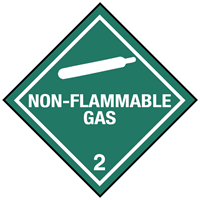
 Print
Print
Chemical Datasheet
CARBON DIOXIDE AND OXYGEN MIXTURE |


|
Chemical Identifiers
| CAS Number |
UN/NA Number |
DOT Hazard Label |
USCG CHRIS Code |
- 124-38-9

- 7782-44-7
|
|
- Non-Flammable Gas
- Oxidizer
|
none
|
| NIOSH Pocket Guide |
International Chem Safety Card |
|
Carbon dioxide
|
- CARBON DIOXIDE
- OXYGEN
- OXYGEN (LIQUEFIED)
|
NFPA 704
General Description
Carbon dioxide-oxygen mixture is a colorless odorless gas. Both carbon dioxide and oxygen are noncombustible; however, oxygen can accelerate the burning of a fire. Under prolonged exposure to fire or intense heat the containers may rupture violently and rocket.
Hazards
Reactivity Alerts
Air & Water Reactions
Carbon dioxide is water soluble, and forms carbonic acid, a mild acid in water.
Fire Hazard
No information available.
Health Hazard
No information available.
Reactivity Profile
Pure oxygen is a potent oxidizer. The CO2 is inert, so much of the reactivity of this mixture is connected to the % content of each component. The higher the % content rare gas the less reactive in terms of it being an oxidizing agent. Dusts of magnesium, lithium, potassium, sodium, zirconium, titanium, and some magnesium-aluminum alloys, and heated aluminum, chromium, and magnesium when suspended in carbon dioxide are ignitable and explosive. This is especially true in the presence of strong oxidizers, such as peroxides. The presence of carbon dioxide in solutions of aluminum hydride in ether can cause violent decomposition on warming the residue, [J. Amer. Chem. Soc., 1948, 70, 877]. Dangers arising from the use of carbon dioxide in the fire prevention and extinguishing systems of confined volumes of air and flammable vapors are examined. The hazard associated with its use centers around the fact that large electrostatic discharges may be created that initiate explosion, [Quart. Saf. Summ., 1973, 44(1740, 10].
Belongs to the Following Reactive Group(s)
Potentially Incompatible Absorbents
Use caution: Liquids with this reactive group classification have been
known to react with the
absorbents
listed below.
- Cellulose-Based Absorbents
- Expanded Polymeric Absorbents
Response Recommendations
Isolation and Evacuation
No information available.
Firefighting
No information available.
Non-Fire Response
No information available.
Protective Clothing
No information available.
DuPont Tychem® Suit Fabrics
No information available.
First Aid
No information available.
Physical Properties
Flash Point: data unavailable
Lower Explosive Limit (LEL): data unavailable
Upper Explosive Limit (UEL): data unavailable
Autoignition Temperature: data unavailable
Melting Point: data unavailable
Vapor Pressure: data unavailable
Vapor Density (Relative to Air): data unavailable
Specific Gravity: data unavailable
Boiling Point: data unavailable
Molecular Weight: data unavailable
Water Solubility: data unavailable
Ionization Energy/Potential:
13.77 eV
[From NPG: Carbon dioxide]
(NIOSH, 2024)
IDLH:
40000 ppm
[From NPG: Carbon dioxide]
(NIOSH, 2024)
AEGLs (Acute Exposure Guideline Levels)
No AEGL information available.
ERPGs (Emergency Response Planning Guidelines)
No ERPG information available.
PACs (Protective Action Criteria)
| Chemical |
PAC-1 |
PAC-2 |
PAC-3 |
| Carbon dioxide (124-38-9)
|
54000 mg/m3 |
72000 mg/m3 |
90000 mg/m3 |
(DOE, 2024)
Regulatory Information
EPA Consolidated List of Lists
No regulatory information available.
CISA Chemical Facility Anti-Terrorism Standards (CFATS)
No regulatory information available.
OSHA Process Safety Management (PSM) Standard List
No regulatory information available.
Alternate Chemical Names
- CARBOGEN
- CARBOGEN 240
- CARBON DIOXIDE AND OXYGEN MIXTURE
- CARBON DIOXIDE AND OXYGEN MIXTURE, COMPRESSED
- CARBON DIOXIDE-OXYGEN MIXT.
- CARBON DIOXIDE-OXYGEN MIXTURE
- OXYGEN AND CARBON DIOXIDE MIXTURE
- OXYGEN AND CARBON DIOXIDE MIXTURE, COMPRESSED
- OXYGEN, MIXT. CONTAINING



 Print
Print

